Ford Transit
| Ford Transit | |
|---|---|
_140_T330_van_(2011-11-18)_01.jpg) | |
| Overview | |
| Manufacturer | Ford |
| Production | 1965–present |
| Body and chassis | |
| Class | Light commercial vehicle (M) |
| Chronology | |
| Predecessor |
|
The Ford Transit is a range of light commercial vehicles produced by Ford since 1965. Sold primarily as a cargo van, the Transit is also built as a passenger van (marketed as the Tourneo since 1995), minibus, cutaway van chassis, and as a pickup truck. Over eight million Transit have been sold, making it the third best-selling van of all time[1] and have been produced across four basic platform generations (debuting in 1965, 1986, 2000, and 2013 respectively), with various "facelift" versions of each.
The first product of the merged Ford of Europe, the Transit was marketed through Western Europe and Australia; by the end of the 20th century, it was marketed nearly globally with the exception of North America until 2013 when it replaced the Ford E-Series in 2015. The Transit has been the best-selling light commercial vehicle in Europe for 40 years, and in some countries the term "Transit" has passed into common usage as a generic trademark applying to any light commercial van in the Transit's size bracket.[2][3] While initially designed for European consumption, the Transit is now produced in Asia, North America, and Europe for worldwide buyers. Upon production in North America, the Transit won second place in Motor Trend's 2015 'Truck of the Year' award, behind the newly introduced mid-size Chevrolet Colorado pickup and ahead of the new Ford F-150.[4]
As of 2016, the Transit is the best-selling van in the United States, minivan sales included. The Transit drives Ford's 57 percent share of the full-size van market in the US.[5]
Taunus Transit (1953–1965)
| Ford Taunus Transit | |
|---|---|
|
1964 Ford Taunus Transit | |
| Overview | |
| Also called | Ford Taunus Transit |
| Production | 1953–1965 |
| Assembly | Cologne, Germany |
| Body and chassis | |
| Body style | 3/4-door van |
| Layout | FR layout |
Unlike the British-built Transit "family", the first production Ford to wear the "Transit" badge was a van built in Ford's Köln (Cologne) plant in Germany. It was introduced in 1953 as FK 1000 (Ford Köln carrying 1,000 kg) with a 1.3 litre inline-four engine from the contemporary Taunus. In 1955 the engine capacity was enlarged to 1.5 litres. From 1961, this vehicle was called the Ford Taunus Transit. Production of this model ceased in 1965.
Naming system
The German vehicle was not widely exported, and the "Mark 1" tag has commonly been applied, retrospectively, to the 1965 to 1978 British model (see below). Whilst there has only been four basic platforms since 1965, the various facelifts and upgrades over the years have been referred to using a conflicting range of "Mark" numbers, with some sources counting a facelift as a new "Mark", some not. Ford's own historical look back at Transit production, published for the launch of the 1994 model, avoids the issue by referring to generations of Transit by years produced.[6] This article attempts to make mention of all the common naming systems.
First generation (1965–1986)
Pre Facelift (1965–1978)
| First generation | |
|---|---|
 Mark I long-wheelbase Ford Transit with twin rear wheels and widened arches | |
| Overview | |
| Production | 1965–1978 |
| Assembly |
|
| Body and chassis | |
| Body style | 3/4-door van |
| Layout | FR layout |
| Powertrain | |
| Engine |
petrol |
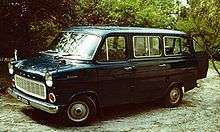
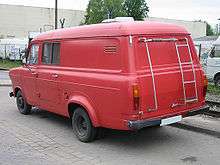
The first generation Transit, or the Transit Mark I in the United Kingdom,[8] was introduced in October 1965, taking over directly from the Thames 400E, and has been in continuous production in three basic generations to the present day.
The van was produced initially at Ford's Langley facility in Berkshire, England (a former Second World War aircraft factory which had produced Hawker Hurricane fighters), but demand outstripped the capability of the plant, and production was moved to Southampton until closure in 2013 in favour of the Turkish factory.[9]
Transits have also been produced in Ford's Genk factory in Belgium and also Turkey. Transits were produced in Amsterdam for the local market from the mid-1970s until the end of 1981. This factory had ample capacity, since the Ford Transcontinental produced there had little success (total production 8000 in 6 years). Although the Transit sold well in the Netherlands, it was not enough to save the factory, which closed in December 1981.
The Transit was introduced to replace the Ford Thames 400E, a small mid-engined forward control van noted for its narrow track which was in competition with similar-looking but larger vehicles from the BMC J4 and J2 vans and Rootes Group's Commer PB ranges. In a UK market segment then dominated by the Bedford CA, Ford's Thames competitor, because of its restricted load area, failed to attract fleet users in sufficient numbers. Ford switched to a front-engined configuration, as did the 1950s by Bedford with their well-regarded CA series vans. Henry Ford II's revolutionary step was to combine the engineering efforts of Ford of Britain and Ford of Germany to create a prototype for the Ford of Europe of today—previously the two subsidiaries had avoided competing in one another's domestic markets but had been direct competitors in other European markets.
The Transit was a departure from the European commercial vehicles of the day with its American-inspired styling—its broad track gave it a huge advantage in carrying capacity over comparable vehicles of the day. Most of the Transit's mechanical components were adapted from Ford's car range of the time. Another key to the Transit's success was the sheer number of different body styles: panel vans in long and short wheelbase forms, pick-up truck, minibuses, crew-cabs to name but a few.
The engines used in the UK were the Essex V4 for the petrol-engined version in 1.7 L and 2.0 L capacities. By using relatively short V-4 engines Ford were able to minimise the additional length necessitated to place the engine ahead of the driver.[10] Another popular development under the bonnet was the equipping of the van with an alternator at time when the UK market competitors expected buyers to be content with a dynamo.[10] A 43 bhp (32 kW) diesel engine sourced from Perkins was also offered. As this engine was too long to fit under the Transit's stubby nose, the diesel version featured a longer bonnet. The underpowered Perkins proved unpopular, and was replaced by Ford's own "York" unit in 1974. For mainland Europe the Transit had the German Ford Taunus V4 engine in Cologne 1.3, 1.5, and 1.7- or Essex 2.0-litre versions. The diesel version's long nose front was also used to accommodate the Ford 3.0 L Ford Essex V6 engine (UK) for high performance applications such as vans supplied to police and ambulance services. In Australia, in 1973, to supplement the two Essex V4 engines that were available the Transit was released with the long-nose diesel front used to accommodate an inline 6-cylinder engine derived from the Ford Falcon.
According to the show Top Gear, British police have reported that in the 1970s, 95% of all robberies in which the criminals used a vehicle involved this type of Ford Transit.[3]
The adoption of a front beam axle in place of a system incorporating independent front suspension that had featured on its UK predecessor might have been seen as a backward step by some, but on the road commentators felt that the Transit's wider track and longer wheelbase more than compensated for the apparent step backwards represented by Ford's suspension choices.[10] Drivers appreciated the elimination of the excessive noise, smell and cabin heat that resulted from placing the driver above or adjacent to the engine compartment in the Thames 400E and other forward control light vans of the 1950s and early 1960s.[10]
Facelift (1978–1986)
| First generation (facelift) | |
|---|---|
.jpg) | |
| Overview | |
| Production | 1978–1986 |
| Assembly |
Genk, Belgium[11][12] Southampton, UK (1978–1986) reaching 2 million Transits on 25 July 1985 Amsterdam, Netherlands (1975–1981) Kocaeli, Turkey (Ford Otosan), from 1976)[13][14][15] Seaview, Lower Hutt (Ford New Zealand) |
| Body and chassis | |
| Body style |
3/4-door van 2-door pickup 4-door minibus 4-door crew cab 2-door chassis cab 2-door Luton/box van |
| Layout | |
| Powertrain | |
| Engine |
petrol 1.6 L Kent/Crossflow I4 1.6 L Pinto I4 2.0 L Pinto I4 2.8 L Cologne V6 3.0 L Essex V6 4.1 L I6 (Australia) diesel 2.5 L York I4 |
| Dimensions | |
| Wheelbase |
SWB: 2,690 mm (105.9 in) LWB: 3,000 mm (118.1 in) |
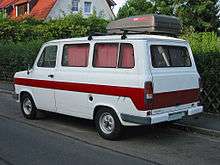
.jpg)
In March 1978, a facelifted version—codenamed within Ford as the "Transit 1978 1⁄2"—but usually referred to as the Transit Mark II,[8] debuted with a restyled nose section, new interior, and the introduction of the Pinto engine from the Cortina in place of the Essex V4. Many fleet owners experienced premature camshaft wear in early Pinto units in the Cortina and for two years the Transit 75 was available with the 1.6 L Ford Kent cross-flow engine. High-performance versions intended for police or ambulance use used the 3.0 L V6 version of the Essex engine, Australian variants had 4.1 L (250 cu in) inline 6-cylinder engines.
In 1984, the York diesel engine was redesigned into the 2.5 L "DI" (direct injection) unit. At this time this generation received a minor facelift including a grey plastic front grille with integrated headlamp surrounds, wraparound indicators, longer bumper end caps and multifunction rear lights incorporating fog, indicator, reversing and side lights for the panel van. This facelift did not commonly result in a new "Mark" number.
The Mark II was available in 6 body styles: Van, Kombi, Chassis Cab, Parcel Van, Bus and Crewbus all available in short-wheelbase (2690 mm) and long-wheelbase (3000 mm) versions. A selection of 5 engines was available: 1.6-litre OHC Petrol, 1.6-litre OHV Petrol (Kent), 2.0-litre OHC Petrol, 2.0-litre OHC Petrol (Economy) and 2.5-litre Diesel. On top of this were 32 door combinations, 6 axle ratios and options for 12 – 17 interior seats. All of these were available in any combination when purchased with Ford's highly customizable custom plan. At the time this gave the business sector an unprecedented amount of flexibility, which was a major factor in the vehicles' ultimate success.[16]
In 1981, for mainland European market only, the Transit Clubmobil was introduced by the Hymer company. This was fitted with a 1.6 / 2.0 OHC engine, and featured a custom interior – captain style swivel seats in velour, pile carpet, motorsport steering wheel, unique Ronal 14" alloy wheels, unique side windows, folding back seat, luggage box, unique front spoiler, tinted glass, power assisted steering, spare wheel carrier and rear door ladder. In 3 years of production 150 were produced and less than 20 are thought to still exist.
In late 1982 a four-wheel drive version was added to the German market. This was developed together with a Ford dealer in Stuttgart.[17] The 4x4 Transit was later offered in other markets as well.
Second generation (1986–2003)
| Second generation | |
|---|---|
.jpg) Pre-facelift Ford Transit | |
| Overview | |
| Production | 1986–2003 |
| Assembly |
Belgium: Genk[11][12] Southampton, UK (1986–2000) Kocaeli, Turkey (Ford Otosan, 1994–2001)[13][14][15] Obchuk, Belarus (Ford Union, 1997–2000)[18][19][20] Hai Duong, Vietnam (Ford Vietnam) (1998–2003)[21] Nanchang, China (Jiangling)(1998–present) |
| Body and chassis | |
| Body style |
3/4-door van 2-door pickup 4-door minibus 4-door crew cab 2-door chassis cab 2-door Luton/box van |
| Layout | FR layout |
| Powertrain | |
| Engine | |
Pre-facelift (1986–1995)
Codenamed VE6, the second generation Transit platform appeared in January 1986 and was notable for its all-new bodyshell which was of "one-box" design (i.e. the windscreen and bonnet are at close to the same angle), and the front suspension was changed to a fully independent configuration on SWB versions. The engine range was carried over largely unchanged from the last of the 1978–85 generation models, although in 1989 the high-performance 3.0 Essex V6 petrol was replaced by the Cologne 2.9 EFI V6, mainly because of emissions regulations as the Essex V6 design was nearly 25 years old by then and still used a carburettor. The third generation Transit was developed under the "Triton" code name.[22] A subtle facelift in 1992 saw the fully independent front suspension adopted across the range, whilst a redesigned floor plan allowed the use of single, rather than paired, rear wheels on the LWB derivative, further increasing payload—these models are identifiable by the slightly more rounded front headlamps. In Australia, the third generation Transit did not go on sale until March 1994, after a 13-year absence from that market.
Facelift (1994–2003)
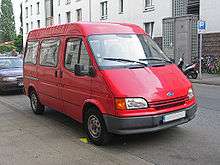
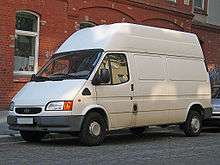
A major facelift to the Transit in 1994 gave the Transit a new nose and dashboard, along with the 2.0 L DOHC 8-valve engine as found in the 1994 to 1998 Ford Scorpio. It is similar to the earlier Sierra DOHC unit but without the distributor and uses the updated OBD II-compliant EEC-V level engine control unit. Some of Ford's 16-valve engines, such as those found in the Scorpio, Escort RS2000 and Galaxy were also based on this block. At the same time air conditioning, electric windows, central locking, electric mirrors and airbags were all made available as optional extras.
The turbo diesel version came in 85 PS (63 kW), 100 PS (74 kW) and 115 PS (85 kW) version with an electronic fuel pump.
For the 30th anniversary of the Transit in 1995 Ford released a limited edition model called the Transit Hallmark. Six hundred were made and were available in three colours with 200 being made in each.
In Europe the VE83 Transit was available up to 2000, but in Vietnam it was built up to 2003 when it was exchanged in June for the new generation.[21]
Third generation (2000–2013)
| Third generation | |
|---|---|
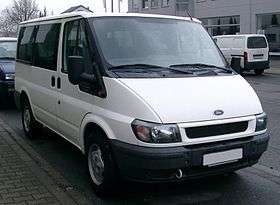 | |
| Overview | |
| Also called | Ford Tourneo |
| Production |
2000–2013 2008–2013, 2015–present (China) 2014–present (Malaysia) |
| Assembly |
Southampton, UK (2000–2013) Kocaeli, Turkey (Ford Otosan[13][14][15] Abchak, Belarus (Ford Union, 1997–2000)[18][19][20] Hai Duong, Vietnam (Ford Vietnam[21] Tatarstan, Russia (Ford Sollers)[23] Nanchang, China (Jiangling) |
| Body and chassis | |
| Body style |
3/4-door van 2-door pickup 4-door minibus 4-door crew cab 2-door chassis cab |
| Layout | Front-engine, front-wheel drive / rear-wheel drive or four-wheel drive |
| Powertrain | |
| Engine |
2.3L I4 2.0L I4 2.2L Duratorq TDCi I4 2.4L Duratorq TDCi I4 3.2L Duratorq TDCi I5 2.3L Duratec I4[24] |
| Transmission |
5-speed manual 6-speed manual (facelift only) |
Pre-facelift (2000–2006)
The 2000 Transit,[25] introduced in July 2000, was the third all-new design, and borrowed styling cues from Ford's "New Edge" designs, like the Focus and Ka. Developed by Ford in the United States, the main innovation is that it is available in either front- or rear-wheel drive. Ford nomenclature makes this the V184 (rear-wheel-drive) or V185 (front-wheel-drive) model. This model features the "Puma"-type Duratorq turbo diesel engine also used in the 2000 Mondeo and Jaguar X-Type, with the petrol versions moving up to the 2.3 L 16-Valve edition of the straight-4 engine. With this engine, the Transit can reach 60 mph (97 km/h) in 21 seconds and reach a top speed of 93 miles per hour (150 km/h), returning it to car-like performance as claimed for the earliest models. A demonstration of this model's speed was shown on Top Gear in 2005, where German race driver Sabine Schmitz attempted to drive it around the Nürburgring in under ten minutes, matching Jeremy Clarkson's time in a turbodiesel Jaguar S-Type; she was unsuccessful, marking her fastest lap at 10m 8s.
This version won the International Van of the Year 2001.

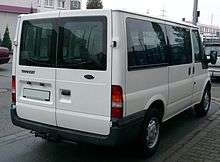
The Durashift EST automatic transmission (optional on all rear-wheel-drive models) features controls mounted on the dashboard, a specially adapted manual mode, tow-haul mode, economy mode and winter mode.
2002 saw the introduction of the first High Pressure Common Rail diesel engine in the Transit, with the launch of the 125 PS (92 kW) HPCR 2.0-litre in the FWD. Production of the van started at the new Ford-Otosan plant in Kocaeli, Turkey which saw the end of all production at the Genk, Belgium plant which had been producing Transits since 1965. This coincided with the introduction of the Transit Connect (also produced in Kocaeli), a smaller panel van based on the C170 (Focus) platform and aimed at replacing the older Escort and Fiesta based models. Despite the name, the Connect has no engineering commonality with the full-size Transit.
2003 saw a new instrument cluster with a digital odometer.
2004 saw the launch of the first RWD HPCR, the 135 PS (99 kW) 2.4-litre variant that also introduced the 6-speed MT-82 RWD manual gearbox.
The five millionth Transit rolled off the Southampton line on Monday, 18 July 2005 and was donated to an English charity.
Facelift (2006–2013)
_140_T330_van_(2011-11-18)_02.jpg)
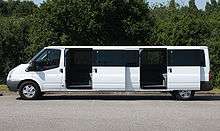
The third generation Transit, received a facelift to the body, introduced in August 2006, including new front and rear lights, a new front end and a new interior featuring the gearstick on the dashboard and Ford's new corporate radio design. Besides the styling changes, the powertrains were revised. The old petrol engine was replaced with one from the Ford Ranger, the front-wheel-drive diesel went from 2.0 to 2.2 litres capacity, and all diesel engines gained high-pressure common rail (TDCi) systems. The powertrains were changed to meet new emissions legislation. The new version (Ford nomenclature V347 for front-wheel drive and V348 for rear-wheel drive) won International Van of the Year for 2007 despite tough competition from several all-new rivals. This Transit arrived in Mexico to replace the Freestar after the 2007 model year. This was the first Transit having a five-cylinder engine.
Mid-2006 saw the launch of the "Sport Van", a production van featuring the 130 PS (96 kW) engine with additional styling parts, "Le Mans" stripes and 18-inch alloy wheels.
Late-2007 saw the launch of the 140 PS (103 kW) engine for front wheel drives (replacing the 130 PS) complete with the VMT6 6-speed manual transaxle to cope with the extra power.
The 6-speed transaxle was introduced on the mid-power FWD in late 2008 when the 110 PS (81 kW) engine was upped to 115 PS (85 kW).
In late-2008, the "coated Diesel Particulate Filter" (cDPF)—designed to meet higher emission standards than the current Euro IV requirement—was introduced as an option on all diesel engines. Production ended in 2013, then China brought it back in 2 modified forms.
Engines
- 2.2 l Diesel, 63 kW (85 PS); 2006–2014
- 2.2 l Diesel, 81 kW (110 PS); 2006–2008
- 2.2 l Diesel, 85 kW (115 PS); 2008–2014
- 2.2 l Diesel, 96 kW (130 PS); 2006–2007
- 2.2 l Diesel, 103 kW (140 PS); 2007–2014
- 2.4 l Diesel, 74 kW (100 PS); 2006–2014
- 2.4 l Diesel, 85 kW (115 PS); 2006–2014
- 2.4 l Diesel, 103 kW (140 PS); 2006–2014
- 3.2 l Diesel, 147 kW (200 PS); 2007–2014
- 2.3 l Petrol, 107 kW (146 PS); 2006–2014
To celebrate the Transit's status as International Van of the Year 2007, Ford built this stretch style van — the Transit XXL. It is a unique special that is among the more expensive Transits ever.[26]
Fourth generation (2013–present)
| Fourth generation | |
|---|---|
 | |
| Overview | |
| Also called |
Ford Tourneo (passenger van, outside North America) Ford Transit 150/250/350/350HD (United States and Canada) |
| Production | Summer 2013–present[27] |
| Assembly |
Kocaeli, Turkey (Ford Otosan)[13][14][15] Claycomo, Missouri, U.S. (Kansas City Assembly) Yelabuga, Russia (Sollers-Ford)[28] Nanchang, China (Jiangling) |
| Designer | Paul Campbell |
| Body and chassis | |
| Class | Full-size van |
| Body style |
Cargo van Passenger van Chassis cab Cutaway van |
| Layout |
Front engine, rear wheel drive Front engine, all wheel drive (Europe only) Front engine, front wheel drive (Europe only) |
| Powertrain | |
| Engine |
Diesel engines 2.0L Duratorq TDCi I4 (China only) 2.2L Duratorq TDCi I4 (Europe only) 2.4L Duratorq TDCi I4 (Europe only) 3.2L Duratorq TDCi/Power Stroke I5 (All markets) Petrol engines 2.0L EcoBoost I4 (China only) 2.3L Duratec I4 (Europe only) 3.7L Ti-VCT V6 (North America only) 3.5L EcoBoost V6 (North America only) |
| Transmission |
6-speed automatic (North America only) 6-speed manual 5-speed manual (China only) |
| Dimensions | |
| Wheelbase |
Cargo & passenger van 129.9 in (3,299.5 mm) (regular)[29] 147.6 in (3,749.0 mm) (long)[29] Cab chassis & cutaway 138.0 in (3,505.2 mm) (short)[30] 155.7 in (3,954.8 mm) (regular)[30] 178.0 in (4,521.2 mm) (long)[30] |
| Length | 217.8–266.1 in (5,532.1–6,758.9 mm)[29][30] |
| Width | 80.8–83.7 in (2,052.3–2,126.0 mm)[29][30] |
| Height | 82.2–110.1 in (2,087.9–2,796.5 mm)[29][30] |
| Chronology | |
| Predecessor | Ford E-Series (North America) |
_290S_van_(2015-07-03)_01.jpg)
_350E_van_(2015-06-03)_02.jpg)
The fourth generation of the Transit was officially launched in January 2013 at the North American International Auto Show[31] in Detroit.
A OneFord globally developed vehicle, the new-generation Transit was designed by Ford of Europe and co-developed with Ford in North America. In a break from the previous generation of the Transit, there are two distinct body forms:
- Mid-size front wheel drive: now a distinct model, branded Transit/Tourneo Custom. It is intended to compete with vehicles such as the Mercedes-Benz Vito/Viano and Volkswagen Transporter T5.
- Full size rear wheel drive: a full size version, to enable Transit to better replace the outgoing 40-year-old Econoline/E-Series in the North American market.[32] While the front-wheel drive V347 Transit was sold alongside the E-Series in Mexico starting in 2007 (replacing the Freestar minivan), this generation of the Transit is the first to be officially sold in the United States and Canada. As part of the development cycle, Ford loaned examples of the previous-generation (V347/348) Transit to high-mileage drivers in the United States for evaluation purposes and durability testing.
Both versions external design look evolved from the New Edge styling used from the previous-generation model to the Kinetic design adopted by the OneFord global models since 2010; the interior drew cues from the third generation Ford Focus.
Model configuration
The new Transit is available in cargo van and chassis/cutaway cab configurations. In a significant departure from the E-Series, but standard for existing rest of world versions, Transit vans/wagons come in three different roof heights; extended-wheelbase vans are available with dual rear wheels. It was released in North America in the summer of 2014, released as a 2015 model. As with the much smaller Transit Connect, passenger versions are marketed under a singular Transit nameplate rather than the Tourneo name seen globally.
Outside of North America, much of the Transit engine lineup and drivetrain configurations are retained from the previous generation. For the United States and Canada, the four cylinder engines and manual transmission are not offered; in these markets only the 180-hp 3.2L Duratorq I5 diesel (branded as a PowerStroke) is shared with global-market models. For North America, the standard engine is a 275-hp 3.7L Ti-VCT V6 (shared with the F-Series and Police Interceptor version of the Ford Explorer) and an optional 320-hp 3.5L EcoBoost V6 shared with the F-150 and D3-platform vehicles. All versions in North America are specified with a 6-speed automatic transmission and rear-wheel drivetrain. The 3.7L Ti-VCT V6 can be converted to run on compressed natural gas or liquefied petroleum gas with an optional Gaseous Engine Prep Package.[33] In North America, 4x4 conversions are done through factory-supported third party installers.
Production
Worldwide production of Ford Transits takes place in two facilities; all European Transit production is from Ford Otosan in Kocaeli Province, Turkey; this factory will also provide a percentage of global exports. In February 2015, Ford announced a new Transit production center in Valencia, Spain, to serve growing export markets.[34] North American production is primarily sourced from Kansas City Assembly in Claycomo, Missouri on the lines used for the previous generation Ford Escape; production at the Kansas City Assembly Plant began on 30 April 2014.[35]
Chinese production (2006–present)
| Ford Transit (China) | |
|---|---|
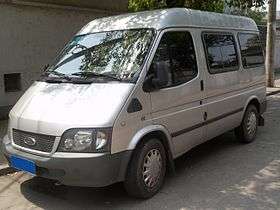 | |
| Overview | |
| Production | 2006–present |
| Assembly | Nanchang, China (Jiangling) |
| Body and chassis | |
| Body style | 4-door van |
| Layout | FR layout |
| Platform | VE83 |
| Powertrain | |
| Engine |
Diesel engines JX493ZLQ(ISUZU 4JB1) 2771cc I4 Petrol engines Shenyang Mitsubishi 4G64S4N 2351cc I4 |
| Transmission | 5-speed manual |
| Dimensions | |
| Wheelbase | 140.55 in (3,570 mm) |
| Length | 213.31 in (5,418 mm) |
| Width | 77.27 in (1,963 mm) |
| Height | 87.87 in (2,232 mm) |
| Kerb weight | 1,920–2,030 kg (4,233–4,475 lb) |
The Ford Transit VJX6541DK-M is a Chinese market specific version, and is based on the third generation VE6/VE94 platform. This generation is only built in Nanchang by Jiangling Motors and is reserved for the Chinese domestic market. Remarkable are the much larger headlights and the larger grille. The model was launched to the market in 2006. Overall, the generation has 70 improvements to its predecessor. The interior has been changed and made more ergonomic. Power windows are standard, but ABS is optional. The Chinese Transit is available with two diesel engines and one petrol. One of them has a power of 67.6 kW (Type JX493ZQ3), the other 68 kW (JX493ZQ4). Both diesels have a capacity of 2,771 cc.The later diesel version has a common-rail 2.8-liter unit (with turbo-charger and intercooler) that produces 80–85 kW. The Petrol version uses a Mitsubishi 4G64S4N Engine 92 kW inline-four motor. The top speed is specified at 68.35 mph (110 km/h). The Chinese Transits have a VIN in following form: LJXBMCH1××T××××××.
The European 2006 Ford Transit went into production in 2008. On the Chinese market it is known as the New Transit. It is offered parallel to the 2006 China generation. The two facilities are currently manufacturing 300,000 units annually. Ford and Jiangling want to open a third plant in late 2012 to increase the annual production to further 3,000 units.[36]
In January 2010, the Toyota recalls affected the products of the Ford Group because Ford used the same supplier (CTS Corporation). It was suspected that the accelerator pedals were defective and posed a danger. About 1600 Ford Transits of the 2006 China generation were affected by the recall.[37]
The European models of the VE6 and VE8 generation can be given an aftermarket facelift to the Chinese version. This needs the Chinese components and manual skills. Production briefly ended in 2013, alongside the European Transit as the Ford of China website changed, however, it came back into production alongside the old European Transit.[38]
Variants
County 4x4
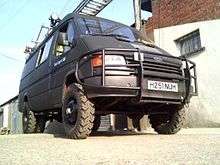
A handful of companies offered four-wheel-drive conversions, such as County Tractors of Knighton in Powys,[39] who converted vans on behalf of Ford as a Special Vehicle Operations factory option. The first Transit County models were based on the Mk2 Transit model, both long and short wheelbase. The conversion used a Dana 44F front axle and a NP208 transfer box, both lifted from the Ford Bronco, coupled to the regular Transit engine, gearbox and rear axle using three custom propshafts. The Transit rear axle was retained, mounted to a rear subframe or 'lift cradle' to give the extra ride height. Other modifications were 16-inch wheel rims, locking front hubs, a heavy-duty steering box and 305 mm diameter front brake discs.
With the introduction of the Mk3 Transit in 1986 came the next generation of the County 4x4. This would prove to be a very popular and successful version of the County Transit 4x4, and the last to use the Dana beam axle layout. Later County 4x4 models switched to using an independent front suspension setup which was inherently more complex in design than the earlier beam axle models. Later panel vans also lost the twin-wheel rear axle that had been fitted on earlier LWB versions.
Mainly used by utility companies such as National Grid, the Ministry Of Defence, and by mountain rescue teams, the Transit County 4x4 proved to be a capable vehicle both on and off road, with the ability to carry both crew and equipment just about anywhere.
Design and supply of drivetrain components for County 4x4 models passed to Countytrac, a division of M.J. Allen Ltd, who are still involved in the development of the latest Mk7 AWD Transit and Connect models.
Tourneo
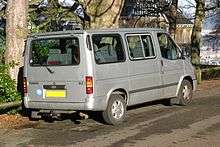
Introduced as part of the 1995 redesign of the Transit, the Tourneo is a Transit-based 8 or 9-seat minibus, but over the years has become increasingly better trimmed to the point where it can almost be classified as a large MPV. Featuring back seats and back windows similar to a minivan, the Tourneo is also considered an executive transport vehicle and is often supplied with alloy wheels. Since its introduction, the Tourneo has followed the same development cycle as the Transit; both versions receive updates at the same time.
A smaller minivan version of the Tourneo was introduced in 2002; branded the Tourneo Connect, it was based on the Transit Connect mini MPV.
References
- ↑ "Top 20 best-selling vans of all time". Parkers Van News. Bauer Media. Retrieved 12 August 2015.
- ↑ "Meaning of "transit" in the English Dictionary". Cambridge Dictionaries Online. Cambridge University Press. Retrieved 27 May 2016.
- 1 2 "Series 06, Episode 07". Top Gear. Series 6. Episode 7. 10 July 2005. BBC.
- ↑ Welch, David (3 December 2014). "Ford's New F-150 Loses Truck of Year Award to Chevy". Bloomberg L.P. Retrieved 4 May 2016.
- ↑ Cain, Timothy (29 April 2016). "Ford Transit Is America's Best-Selling Van, Minivans Included". The Truth About Cars. Retrieved 1 May 2016.
- ↑ "Van World" marketing periodical; in article "1965–1995: 30 years and 3,000,000 Transits later"; pub. Ford Motor Company Ltd., Brentwood, UK; Autumn 1994.
- 1 2 Becker, Clauspeter (1971), Logoz, Arthur, ed., "Fiat 128", Auto-Universum 1971 (in German), Zürich, Switzerland: Verlag Internationale Automobil-Parade AG, XIV: 109
- 1 2 "Ford Transit van club signs 1,000th member". Ford UK. 23 April 2012. Retrieved 14 August 2013.
Darren, whose 1986 Mk II long wheelbase Transit is in daily use [...] was delighted to find himself a milestone member: [...] "The Transit has been part of my life since I first started driving one in 1996, and now I have bought a second classic model, a 1969 Mk I camper van, as a restoration project."
- ↑ "Last shift at Ford's Transit van factory in Swaythling". BBC. 26 July 2013. Retrieved 26 July 2013.
- 1 2 3 4 Maurice A Smith (Ed) (18 April 1968). "The [Ford] Light Commercials". Autocar. 128 (3766)): 105.
- 1 2 "Facilities". Ford Motor Company Newsroom. Retrieved 27 July 2010.
- 1 2 "Ford Belgien". Ford Oldtimer und Motorsport Club Cologne e.V. Retrieved 27 July 2010.
- 1 2 3 4 "Ford-Otosan". Ford Oldtimer und Motorsport Club Cologne e.V. Retrieved 27 July 2010.
- 1 2 3 4 "Ford Transit". Ford Oldtimer und Motorsport Club Cologne e.V. Retrieved 27 July 2010.
- 1 2 3 4 "Ford Opens Commercial Vehicle Assembly Plant in Turkey". Find Articles. 3 May 2001. Retrieved 27 July 2010.
- ↑ "The New Ford Transit – Confidential for Ford Salesmen Only (Mark II)."
- ↑ Kacher, Georg (September 1982). Kennett, Pat, ed. "Intertruck: Germany". TRUCK. London, UK: FF Publishing Ltd: 25.
- 1 2 "Hell on wheels?". The Economist. 24 July 1997. Retrieved 27 July 2010.
- 1 2 "Ford To Halt Assembly In Belarus July Due To Low Demand". Find Articles. 2 June 2000. Retrieved 27 July 2010.
- 1 2 Miller, Russel R. (1998). Selling to newly emerging markets. p. 192. ISBN 978-1-56720-044-7. Retrieved 28 July 2010.
- 1 2 3 "Facilities". Ford Motor Company Newsroom. Retrieved 27 July 2010.
- ↑ Walker, Alan (September 1982). Kennett, Pat, ed. "The Great European Retreat". TRUCK. London, UK: FF Publishing Ltd: 37.
- ↑ "Ford Sollers Joint Venture Starts Work Today in Russia; Announces Ford Explorer SUV to be Built in Tatarstan". Ford Motor Company Newsroom. 1 October 2011.
- ↑ "Ford Transit Powertrain". Ford.co.uk. Retrieved 15 October 2010.
- ↑ "TRANSIT/TOURNEO CONNECT PRESS PACK". Ford Media Center. Retrieved 14 August 2013.
The year 2000 saw the launch of our fourth generation, all-new Transit, thirty-five years after the original model's debut.
- ↑ "Ford Transit". Retrieved 18 June 2015.
- ↑ Dornbrook, James (30 April 2014). "Ford Transit vans start rolling off line in KC". bizjournals.com. Photo credit: James Dornbrook, KCBJ. Archived from the original on 6 May 2014. Retrieved 6 May 2014.
- ↑ "New Ford Tourneo Custom Priced at $47,500". Wroom.ru. Wroom.ru. Retrieved 19 June 2014.
- 1 2 3 4 5 "TRANSIT Specifications". Ford.com. Retrieved 12 October 2014.
- 1 2 3 4 5 6 "TRANSIT CC-CA Specifications". Ford.com. Retrieved 12 October 2014.
- ↑ "2015 Ford Transit". Detroit Free Press. Retrieved 17 January 2013.
- ↑ http://www.ford.com/commercial-trucks/transit/
- ↑ "2014 Transit: Alternative Fuel Capability". Ford Motor Company. Retrieved 1 June 2013.
- ↑ "Ford Investing in Spain Plant that Builds Transit Connect". Truck Trend. 5 February 2015.
- ↑ "2,000 New Ford Kansas City Employees Celebrate Start of Production of Game-Changing 2015 Ford Transit Van". ford.com.
- ↑ Sun Press (18 July 2010). "Ford breaks ground on $300 million China plant". Yahoo! News. Archived from the original on 22 July 2010. Retrieved 26 July 2010.
- ↑ Peskett, Karl (30 January 2010). "Ford Transit production in China also stopped due to pedal issues". Car Advice. Retrieved 26 July 2010.
- ↑ "Ford Transit facelift parts arrived!". Foongleongsoon.blogspot.com. 18 July 2007. Retrieved 26 July 2010.
- ↑ "History". Ford Transit County 4X4. Retrieved 17 March 2011.
External links
| Wikimedia Commons has media related to Ford Transit. |
- Official Australia Ford All-new Transit website
- Official UK Ford Transit website
- USA Ford Transit website
| Ford automobile timeline, European market, 1960s–1980s — next » | ||||||||||||||||||||||||||
|---|---|---|---|---|---|---|---|---|---|---|---|---|---|---|---|---|---|---|---|---|---|---|---|---|---|---|
| Type | 1960s | 1970s | 1980s | |||||||||||||||||||||||
| 0 | 1 | 2 | 3 | 4 | 5 | 6 | 7 | 8 | 9 | 0 | 1 | 2 | 3 | 4 | 5 | 6 | 7 | 8 | 9 | 0 | 1 | 2 | 3 | 4 | 5 | |
| Supermini | Fiesta I | Fiesta II | ||||||||||||||||||||||||
| Small family car | Anglia 105E / Super Anglia 123E | Escort I | Escort II | Escort III | ||||||||||||||||||||||
| Large family car | Consul II | Cortina I | Cortina II | Cortina III / Taunus TC | Cortina IV/Taunus TC | Cortina V/Taunus TC | Sierra | |||||||||||||||||||
| Taunus P1 | Taunus P4 | Taunus P6 | ||||||||||||||||||||||||
| Classic | Corsair | |||||||||||||||||||||||||
| Executive car | Taunus P3 | Taunus P5 | Taunus P7a | Taunus P7b | ||||||||||||||||||||||
| Consul (Granada) | ||||||||||||||||||||||||||
| Granada I | Granada II | |||||||||||||||||||||||||
| Zephyr II | Zephyr 4/6 III | Zephyr 4/6 IV | ||||||||||||||||||||||||
| Zodiac II | Zodiac III | Zodiac IV & Executive | ||||||||||||||||||||||||
| Coupé | Consul Capri | Capri I | Capri II | Capri III | ||||||||||||||||||||||
| Van | Taunus Transit | Transit I | Transit II | |||||||||||||||||||||||
| « previous - Ford Motor Company light truck timeline, United States & Canada, 1980s–present | |||||||||||||||||||||||||||||||||||||||
|---|---|---|---|---|---|---|---|---|---|---|---|---|---|---|---|---|---|---|---|---|---|---|---|---|---|---|---|---|---|---|---|---|---|---|---|---|---|---|---|
| Type | 1980s | 1990s | 2000s | 2010s | |||||||||||||||||||||||||||||||||||
| 0 | 1 | 2 | 3 | 4 | 5 | 6 | 7 | 8 | 9 | 0 | 1 | 2 | 3 | 4 | 5 | 6 | 7 | 8 | 9 | 0 | 1 | 2 | 3 | 4 | 5 | 6 | 7 | 8 | 9 | 0 | 1 | 2 | 3 | 4 | 5 | 6 | 7 | ||
| Crossover | Compact | Escape | Escape | Escape | |||||||||||||||||||||||||||||||||||
| Mid-size | Edge | Edge | |||||||||||||||||||||||||||||||||||||
| Full-size | Freestyle | Taurus X | Explorer | ||||||||||||||||||||||||||||||||||||
| Flex | |||||||||||||||||||||||||||||||||||||||
| Sport-utility vehicle | Compact | Bronco II | Bronco II | ||||||||||||||||||||||||||||||||||||
| Mid-size | Explorer | Explorer | Explorer | Explorer | |||||||||||||||||||||||||||||||||||
| Full-size | Bronco | Bronco | Bronco | Expedition | Expedition | Expedition | |||||||||||||||||||||||||||||||||
| Excursion | Expedition EL/Max | ||||||||||||||||||||||||||||||||||||||
| Pickup truck | Compact | Courier | Ranger | Ranger | Ranger | Ranger | |||||||||||||||||||||||||||||||||
| Mid-size | Explorer Sport Trac | Explorer Sport Trac | |||||||||||||||||||||||||||||||||||||
| Full-size | F-Series (all) | F-Series (all) | F-Series (all) | F-150/F-250 | F-150 | F-150 | F-150 | ||||||||||||||||||||||||||||||||
| SVT Lightning | SVT Lightning | SVT Raptor | Raptor | ||||||||||||||||||||||||||||||||||||
| Super Duty | Super Duty | Super Duty | Super Duty | ||||||||||||||||||||||||||||||||||||
| Van | Compact MPV | Transit Connect | Transit Connect | ||||||||||||||||||||||||||||||||||||
| C-MAX | |||||||||||||||||||||||||||||||||||||||
| Minivan | Aerostar | Aerostar | |||||||||||||||||||||||||||||||||||||
| Windstar | Windstar | Freestar | |||||||||||||||||||||||||||||||||||||
| Full-size | Econoline | Econoline/E-Series | |||||||||||||||||||||||||||||||||||||
| Transit | |||||||||||||||||||||||||||||||||||||||